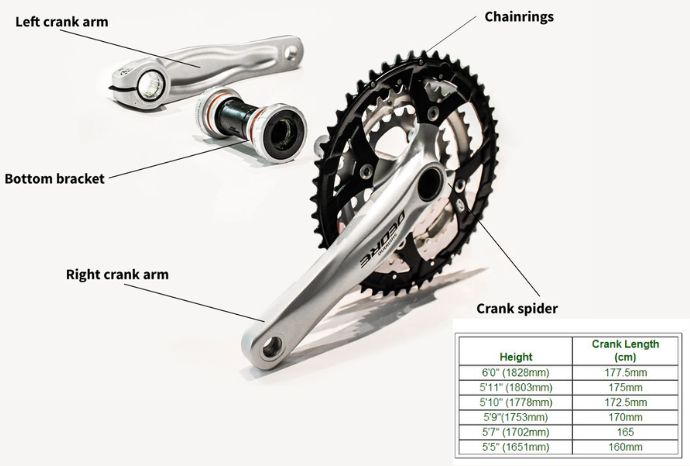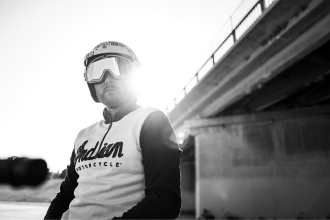Bike crank length selection has long been a fascinating concept. In reality, the proper crank length can lower the risk of injury while enhancing the pedal stroke’s biomechanical performance.
The distance between the bottom bracket and pedal axis centers is measured as the crank length. Although cranks between 165 and 180 mm can be purchased, the most popular lengths are 170, 172.5, and 175
Finding the ideal balance is the main consideration when choosing crank length, and several aspects must be considered. Anthropometric measurements used to be the only reliable source for determining crank length. Recent advancements in power meters and laboratory investigations have made it possible to conduct more thorough analysis in order to make the best decision.
Can Read More:
- 8 Useful Benefits of Mountain Biking
- 7 Benefits of Cycling in the Rain
- Mountain Bike Training Plan
- Mountain Biking Must Adventure in 2024
- Mountain Bike Riding’s Benefits
Main Differences
The distance that the foot must cover to accomplish a pedal stroke is decreased with a short crank. As a result, it favors a higher cadence with the same ratio and force applied to the pedal.
While a longer crank length for height enables a rider to push/pull harder ratios, it is more challenging to keep a high cadence.
Therefore, people who compete in events with plenty of tempo variations and those who naturally pedal more quickly should choose for the shorter cranks. On the other hand, long cranks are better suited to continuous efforts like time trials and to riders who prefer to tackle numerous climbs at a steady pace.
That aside, it is important to consider your own emotions and pedaling technique. Long cranks may be better for people who prefer strong pedal strokes at relatively low cadences; short cranks may be better for people who always travel at high cadences on a mountain bikes.
Crank length optimization study
There is a significant correlation between your cadence and your ideal crank length, as demonstrated by both practical research and theoretical calculations. A crank that is relatively shorter is preferable for you if your cadence is quite high. A somewhat longer crank will fit you better if you pedal with a low cadence.
The ideal cadence now depends on a variety of contradictory criteria and is also personal. According to the amount of oxygen consumed relative to the amount of power produced, a low cadence (about 60 rpm) is the most effective. However, the muscle strain and joint load are substantially higher at such a low tempo. causing weariness to set in earlier, a potential overload, cramping, or even injury. For a quicker recovery, grand tour participants frequently ride at a high cadence.
Your muscle type, the weight of your legs, and your power output are other elements that affect your ideal cadence. Higher cadences are excellent for the performance of fast muscle fibers, light legs, and high power.
This also explains why bikers who are taller may not always require a longer crank. You will likely cycle with a high cadence if you are tall with light, thin legs, ride quickly, and have rapid muscle fibers that have received proper training. So a crank that is somewhat shorter would be better for you. A somewhat longer crank will be advantageous for a less-trained, shorter rider with heavier legs and a lower cadence.
How to Use a Crank Length Calculator?
- Your inseam measurement (barefoot from the ground to the top of your groin)
- The calculator should provide you with an exact length for any distance bike riding, including road, gravel, touring, XC MTB, etc. You can subtract 5 mm if you ride enduro or trail MTB.
- For BMX and downhill, you can subtract up to 10mm. (Remember that you shouldn’t go above the allotted length, but you can if you like.)
Please Note: Only an estimate of your ideal crank length for height in proportion to leg length is given by the crank length calculator. Consult a qualified bike fitter if you are unsure.
Final Thoughts
Recent research suggests that longer cranks are not always preferable (despite common belief). You should take your leg length and the type of riding you plan to conduct into account when picking the crank length.
You must understand that the ideal crank length is all about comfort and convenience, not about performance. You might be surprised to learn that there is just a 1.6% power difference between crank lengths of 145mm and 170mm. Therefore, a 5mm difference will have almost no impact on power.
Since every rider reacts differently to a change in crank size, there is no set norm.
For a novice, it is advised to steer clear of length extremes and to consult a table of anthropometric values. The most recent scientific review does, however, suggest taking the shorter measure if you are deciding between two lengths because there are various biomechanical and postural benefits to doing so:
- Improved respiration and less pressure on the femoral arteries due to a more open hip-femur angle
- Less risk of a knee injury;
- Higher cadence at the same gear and power;
- Better torso flexion and consequently improved aerodynamic position.
FAQS
1. Do Longer Cranks Improve Pedaling Efficiency?
It’s crucial to avoid using excessively long cranks because they can be uncomfortable and push you to run your saddle too low. There is a widespread misconception that longer cranks increase power and pedaling efficiency, although this has been disproven (see a study here).
Shorter cranks are frequently beneficial for many mountain bikers and BMX riders since they help reduce pedal strikes, allow manufacturers to lower the frame’s bottom bracket (BB), which can assist cornering, and also help place the rider in a better position on the bike.
2. Are Shorter Mountain Bike Cranks Better?
Mountain bike cycle cranks that are shorter would undoubtedly be an upgrade. In a research study, it was discovered that shorter cranks helped mountain bicycle riders develop their maximum power more quickly. Moreover, when pedaling off-road, shorter cranks are less prone to catch on obstructions.
3. Are My Cranks Too Long?
You might want to think about acquiring shorter cranks if yours are longer than what our calculation suggests. Consult a professional bike fitter for advice if you’re uncertain.







